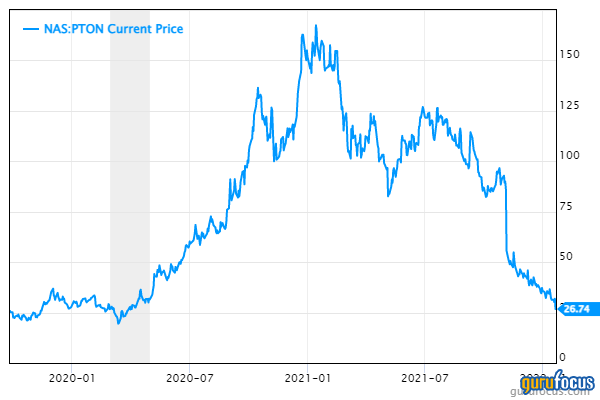Shares of Peloton Interactive Inc. (PTON, Financial) fell a whopping 17% on Thursday after the announcement that the company is halting production of its bikes and treadmills.
Management greatly overestimated the demand for Peloton’s products following pandemic-related pull-forward, and now it’s paying the price. Shares were around the $26.74 mark in midday trading on Jan. 20, continuing the downward spiral from a high of over $167 this time last year.
However, the company does have a 92% customer retention rate as of its latest earnings report, which is quite high and is consistent with its historical average. Peloton is still a leader when it comes to interactive fitness from home and, despite demand being artificially pulled forward in 2020, growth could still be ahead. With the stock trading below its pre-pandemic price, could Peloton soon hit value territory?
Stopped in its tracks
According to confidential internal documents obtained by CNBC, Peloton is temporarily halting production of its connected fitness equipment. Dated Jan. 10, the documents stated waning demand and the need to control costs as the reasons for the production halt.
This revelation has spooked many investors who were previously thinking the stock would soon recover. Making matters worse, rising inflation around the world is making customers more price-sensitive, and at-home fitness equipment falls definitively under the category of non-essential purchases.
According to the documents, production of Peloton’s Bike will be paused for two months, while production of its Tread will be halted for six weeks. Previously, the company had already halted Bike+ production in December of 2021, and this will continue until June. Tread+ production will continue to be down for the entirety of fiscal 2022 after a safety recall last year.
Competitors are also stepping up their game. So far, Peloton has enjoyed a dominant market position as the first company to create such a beloved interactive at-home fitness brand. However, it doesn’t have a patent on exercise bikes, treadmills, tablets or exercise classes, so its only source of moat is its brand value (much like with clothes and shoes).
The price of hubris
When it was founded in 2012, Peloton aimed to revolutionize at-home fitness by making interactive bike workouts more accessible. Spin classes are prohibitively expensive for many people, and others don’t have the extra time in the day to drive to and from an exercise class.
Without the pandemic, the company likely would have grown at a slow but steady pace after it began delivering bikes to homes in 2014. However, when Covid-19 began sweeping through the world, most former gym-goers found themselves without their favorite workout equipment. Demand for Peloton’s bikes exploded as a result of the increase in demand for at-home workout equipment or, more specifically, for workout equipment that still provided some level of interaction even without the gym.
The resulting surge in sales helped solidify Peloton’s brand value, but this also caused the company to overestimate its long-term growth potential.
Even though management was aware of the pull-forward in demand, that didn’t make it any easier to estimate what growth would look like once people began returning to gyms and in-person workout classes. How many people would really go back to public workouts immediately? How many would keep working out at home for the long term?
More likely than not, there was also some pressure from its business model at play as well. Peloton borrowed significant amounts of capital to scale up operations quickly. The more bikes it could sell, the more monthly workout subscriptions it could sell, and once the subscriptions made up for the company’s capital expenditures, then it could really begin raking in the dough.
The downside of this risky growth strategy is that if there aren’t enough buyers for the inventory produced, then the company will have spent all that extra money for nothing and ended up with growing unsold inventory (thus the recent production pauses). If the company can’t return to expected growth levels, it may find itself permanently weighed down by debt.
Keep an eye on subscriber numbers
While the demand pull-forward, overproduction and debt will likely be long-term issues for Peloton, there is one ray of hope. If it can keep its subscriber retention rates high and keep growing its subscriber base, then its stock could become a value opportunity at some point.
In its first quarter of fiscal 2022, Peloton reported that its connected-fitness subscribers exercised an average of 16.6 times per month. While this was down from the peak of 26 per month half a year ago, that doesn’t actually matter to Peloton in terms of profits – it’s still bringing in the same monthly subscription fees.
What’s important is that most people are keeping their subscriptions, with the company recording a 12-month subscriber retention rate of 92%. The 8% that aren’t retained are currently more than compensated for by subscriber growth; at the end of the first quarter of fiscal 2022, the company had 2.49 million connected-fitness subscribers, up 87% year over year.
The subscription model is high-margin and sticky. Over the years, continued subscriber growth could make up for Peloton’s post-lockdown troubles and bring the company back to profitability.
Takeaway
Peloton’s stock was absurdly overvalued at the beginning of 2021, and when we consider the company’s current troubles, it even seems likely to be overvalued now. The combination of pandemic-related demand pull-forward and overproduction of products doesn’t bode well, especially when the company was counting on higher continued growth in order to support its debt levels.
Continuing to keep subscription growth rates and subscriber retention rates high could eventually turn this stock into a value opportunity, though. This outcome is far from certain, and investors who are interested in the stock will want to keep a close eye on future developments before deciding whether to pull the trigger. However, the possibility is there, especially if Peloton can maintain its brand value.


